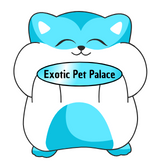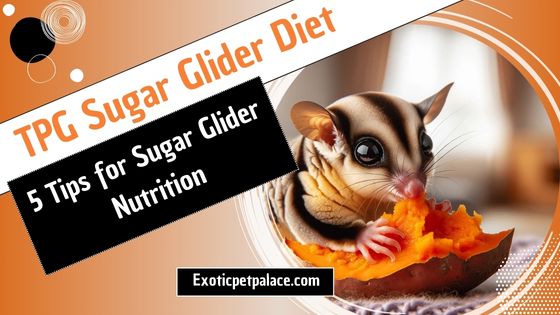Sugar gliders are charming marsupials native to Australia and New Guinea.
These clever and gregarious creatures are growing more popular as exotic pets.
However, a good diet is critical to their health and well-being.
The Pet Glider Diet (TPG) is one of the most popular and well-known diets for sugar gliders in captivity.
This article will go over the TPG diet, its components, preparation procedures, and the nutritional requirements of sugar gliders.
Let’s start,
Also Read:
BML Sugar Glider Diet (A Deep Dive into Sugar Glider Nutrition)
What To Feed A Sugar Glider?|A Guide to Glider’s Dietary Needs|
History and Philosophy of the TPG Diet:
The TPG diet was created by Priscilla Price, the owner of The Pet Glider in Texas.
This diet promotes the consumption of fresh food and a handmade approach to sugar glider nutrition.
It aims to replicate the diverse diet that sugar gliders have in the wild, including insects, fruits, vegetables, and sap.
The TPG diet is designed to provide a balanced and comprehensive diet that meets all the essential vitamin, mineral, and nutrient requirements for sugar gliders.
Now, let’s explore the benefits of the “TPG Sugar Glider Diet.”
Benefits of the TPG Diet:
The TPG diet offers several advantages for sugar gliders:
Balanced Nutrition: Provides a complete and balanced diet that meets all the essential nutrients sugar gliders require.
Variety: Encourages a diverse diet similar to what they would encounter in the wild, promoting a natural foraging instinct and reducing boredom.
Freshness: Emphasizes fresh foods to provide high vitamin and mineral content.
Customization: Allows for customization based on your sugar gliders’ preferences and dietary needs.
Bonding Opportunity: Preparing the TPG staple together with your sugar gliders can be a fun and rewarding bonding experience.
Dental Health: Dry staples like kibble provide a crunchy texture to help maintain healthy teeth.
I hope you understand the importance of the TPG Sugar Glider Diet.
Let’s see what is the composition of the TGP diet.
Components of the TPG Diet:
The TPG diet consists of several key components, each playing a vital role in a sugar glider’s well-being:
- TPG Staple:
- TPG Vitamins with Calcium
- Dry Staples:
- Protein Source:
Let’s see the details:
TPG Staple:
This is the TPG diet’s base, a handcrafted blend of fruits, vegetables, protein, and other necessary nutrients.
TPG Vitamins with Calcium:
Sugar gliders require a certain calcium-to-phosphorus ratio.
These precisely prepared vitamins provide adequate calcium intake and avoid nutritional deficits.
Dry Staples:
These provide essential nutrients and offer crunchy textures for dental health.
Options include commercially available sugar glider kibble or “Monkey Biscuits.”
Protein Source:
Sugar gliders are insectivores, hence protein is an essential element of their diet.
Cooked chicken, turkey, and scrambled eggs are all wonderful options.
Treats:
While treats should be offered sparingly, they can be a great way to provide enrichment and variety.
Options include plain yogurt, small amounts of dried fruits (like mango or pineapple), or occasional fresh vegetables like sweet potato.
As we know the composition of the “TPG Sugar Glider Diet”, now let’s learn how to prepare it.
Preparing the TPG Staple
The TPG staple is the heart of the diet, and its preparation involves several steps:
Fruits and Vegetables:
Use a variety of fresh or frozen (no added sugar or seasoning) fruits and vegetables.
Popular choices include oranges, papayas, sweet potatoes, kale, green beans, and blueberries.
Avoid these foods because they are toxic to gliders:
- Rhubarb
- Onions
- Garlic
Protein Source:
Cooked, boneless, skinless chicken breast, ground turkey, or scrambled eggs are excellent protein options.
Avoid processed meats or meats with high-fat content.
Other Ingredients:
Plain, unsweetened applesauce, low-fat yogurt, and a small amount of calcium-fortified orange juice are other key ingredients in the TPG staple.
Mixing:
Finely chop the fruits and vegetables.
Combine all ingredients in a large bowl and mix thoroughly.
Depending on the desired consistency, you can add a small amount of cooked oatmeal to create a thicker mix.
Vitamins and Minerals:
Before serving, sprinkle the required quantity of TPG Vitamins and Calcium over the basic mix.
Here are some additional tips for preparing the TPG staple:
- Make large batches and freeze them in portion-controlled containers for easy daily feeding.
- Thaw frozen portions in the refrigerator before serving.
- Adjust the recipe based on your sugar gliders’ preferences.
- Ensure all ingredients are fresh and safe for consumption.
Daily Feeding Regimen with TPG
Here’s a breakdown of a typical daily feeding schedule with the TPG diet:
Morning:
Offer a small amount of dry kibble or Monkey Biscuits to satisfy their early hunger and provide dental stimulation.
Mid-Afternoon/Evening:
Provide the main meal consisting of a tablespoon or two of the thawed TPG staple mix.
Treats:
Occasionally offer a small amount of a safe treat like plain yogurt or a sliver of fresh fruit. Fresh water should be readily available throughout the day.
Important Considerations:
- Portion sizes should be adjusted based on your sugar glider’s age, activity level, and overall health. Consult with a veterinarian for specific recommendations.
- Monitor your gliders’ weight and adjust feeding amounts as needed.
- Leftover food should be removed after a few hours to prevent spoilage.
- Maintain clean feeding dishes and ensure proper hygiene when preparing food.
Drawbacks of the TPG Diet
While the TPG diet offers numerous benefits, there are also some drawbacks to consider:
👉Preparation Time:
To prepare the TPG staple, cut the ingredients and combine them daily or in big quantities for freezing. This may be annoying for certain owners.
👉Ingredient Availability:
Depending on where you live, it might be difficult to get fresh, high-quality foods all year.
👉Spoilage:
The Leftover TPG staple mix can spoil if not removed promptly, leading to waste and potential health risks for your gliders.
👉Nutritional Expertise:
While the TPG diet provides a good framework, some knowledge of sugar glider nutrition is necessary to ensure a truly balanced diet.
Consulting with a veterinarian experienced in exotic pets is highly recommended.
Best Alternatives to the TPG Diet
There are alternative dietary options for sugar gliders, each with its advantages and disadvantages:
◾Commercial Diets:
Several commercially available pelleted diets are particularly designed for sugar gliders.
These diets are easy and require little preparation, but they may lack the diversity and freshness of a home-cooked diet.
◾Leadbeaters’ Possum Mix:
This commercially available mix was initially created for Leadbeater’s possums, who are a close relative of sugar gliders.
While some sugar gliders thrive on this mixture, it may not be nutritionally enough for other individuals.
The best diet for your sugar glider depends on several factors, including your lifestyle, budget, and your gliders’ individual needs.
Consulting with a veterinarian experienced in exotic pet care is crucial to determining the most suitable dietary plan for your furry companions.
5 Tips for Sugar Glider Nutrition
Here are some tips to ensure your sugar gliders receive optimal nutrition:
- Monitor Food Intake: Pay attention to how much your gliders are eating and adjust portion sizes accordingly.
- Fresh Water: Provide a clean water source at all times. Consider using a water bottle with a sipper tube to prevent spills and contamination.
- Hygiene: Maintain clean feeding dishes and wash your hands thoroughly before handling food.
- Dietary Supplements: Veterinarians may recommend additional supplements based on your sugar gliders’ specific needs.
- Variety is Key: While the TPG diet emphasizes variety, occasionally offers safe fruits and vegetables outside the staple mix for enrichment.
FAQs
A: Sugar gliders have a quick metabolism and need to eat frequently.
They cannot survive very long without food, usually less than 12 hours.
Dehydration is a larger risk. Ensure they always have access to fresh water.
A: The TPG diet is a popular homemade option.
Here’s a simplified overview:
👉Combine chopped fruits and vegetables (avoiding harmful ingredients such as onions).
👉Add cooked protein, such as chicken breasts or scrambled eggs.
👉Add in other ingredients, such as applesauce and calcium-fortified orange juice.
👉Before serving, sprinkle TPG Vitamins with Calcium.
Remember:
◾Portion quantities vary according to your glider’s age and activity level.
◾Freeze portions for convenience.
◾Cleanliness is essential during preparation.
◾Consult a veterinarian for particular nutritional guidance.
A: There are two main options for purchasing sugar glider food:
Pet stores: Many pet stores carry commercially available sugar glider diets in pellet form.
Online retailers: Several online retailers specialize in exotic pet food and supplies, offering a wider variety of commercial diets and TPG diet ingredients.
A: Absolutely not. Hamster food is not formulated for sugar gliders’ specific nutritional needs. It can lead to malnutrition and health problems. Stick to diets designed specifically for sugar gliders.
A: Cage sickness isn’t a specific disease, but rather a term used to describe a complex of health issues that can develop in sugar gliders due to improper care.
This includes malnutrition, lack of enrichment, and inadequate cage size.
By providing a balanced diet, a stimulating environment, and proper cage hygiene, you can help prevent cage sickness in your sugar gliders.
Conclusion:
The TPG diet is a well-respected and effective approach to sugar glider nutrition.
By understanding its components, preparation methods, and the overall nutritional needs of sugar gliders, you can ensure your furry friends receive the best possible care and live long, healthy lives.
Remember, consulting with a veterinarian is essential to create a personalized dietary plan that meets your sugar gliders’ unique requirements.

